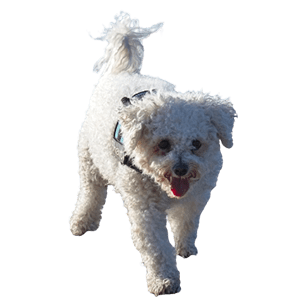Bichon Frise

“The Bichon Frise has roots in the Mediterranean, initially produced by frequently crossing the Barbet (a large water dog) with small coated, white puppies. This cross ultimately made a family of puppies referred to as barbicans, which was later shortened to bichons. The bichons have been divided into four types: Maltaise, Bolognese, Havanese, and Tenerife. The Tenerife considered one of the Bichon Frise sources, evolved at the Canary Island of Tenerife, likely having been taken there by Spanish seafarers in historical times.
In the fourteenth century, Italian sailors brought those puppies back from the island to the Continent, wherein they quickly became favorite pets of the higher class. Following a sequence of French invasions of Italy in the 1500s, the little puppies (recognized there as Bolognese) were followed by the French. They have been unique pets of Francis I and his successor, Henry III. They also enjoyed a reputation in Spain; however, the breed’s reputation waned throughout Europe for a few reasons. The Bichon experienced a brief resurgence during the reign of Napoleon III in the early 19th century. However, it once more quickly diminished from favor and then started a new chapter in the Bichon’s history because the breed sank from court favorite to typical road dog. However, the Bichons survived due to their propensity for performing tricks, and they teamed with peddlers and organ grinders to entertain passersby for money.
With the advent of World War I, the little puppies have been almost lost. Soldiers have brought a few puppies home; however, no attempt to keep the Bichon was made until some French breeders began an earnest effort to set up the breed. In 1933, the FCI adopted a breed standard and formally named it the Bichon Frise. The breed was threatened again, this time through World War II. It was not until it came to the USA in the 1950s that its future became secure. The breed did not catch on until recommended grooming was up to date, and it obtained more exposure in the 1960s. The breed suddenly started catching attention and was identified by the AKC in 1971.”
- Type - Non-sporting
- Weight -10-16 lb
- Height- 9.5-11.5"
- Family -Barbichon, Water Dog
- Date of Orgin-Ancient times
- Area of Orgin -Mediterranean area
- Other Names -Bichon Tenerife, Bichon a Poil Frise
Energy Level
Exercise Requirements
Playfulness
Affection Level
Friendliness To Dogs
Friendliness To Other Pets
Friendliness To Strangers
Watchfulness
Ease of Training
Grooming Requirements
Heat Sensitivity
Vocality
Temperement
Perky, bouncy, and playful, the Bichon Frise’s happy-go-fortunate outlook is endearing to all. This canine is pleasant toward training, strangers and different puppies and pets and is excellent with children. Bichons are sensitive, responsive, and affectionate, as keen to cuddle as they are to play. They don’t want to be left alone and may bark a lot. Bichons may be difficult to housetrain.
Upkeep
The Bichon is an energetic canine that wishes for active indoor games or, better, a romp in the backyard or a quick stroll on a leash daily. The white powderpuff coat wishes brushing and combing every day, plus expert grooming every month. This canine doesn’t shed. However, the loose hairs get entangled in the coat and might mat. Bichons can be challenging to keep white in a few areas.
Health
“Major diagnosis: patellar luxation, Cushing’s, allergies
Minor diagnosis: cataract, CHD
Occasionally seen: liver disease, Legg-Perthes
Suggested tests: hip, knee, eye, DNA for PRA
Life span: 12–15 years”
Disclaimer
Note: While the characteristics mentioned here may frequently represent this breed, dogs are individuals whose personalities and appearances will vary. Please consult the adoption organization for details on a specific pet.
